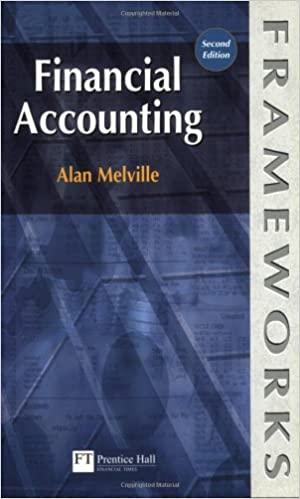Question
Activity-based department rate product costing and product cost distortions Instructions Amount Descriptions Factory Overhead Rates Factory Overhead Costs Activity Table - Receivers Activity Table -
Activity-based department rate product costing and product cost distortions
Instructions
Amount Descriptions
Factory Overhead Rates
Factory Overhead Costs
Activity Table - Receivers
Activity Table - Loudspeakers
Final Question
X
Instructions
Big Sound Inc. manufactures two products: receivers and loudspeakers. The factory overhead incurred is as follows:
| 1 | Indirect labor | $400,400.00 |
| 2 | Subassembly Department | 198,800.00 |
| 3 | Final Assembly Department | 114,800.00 |
| 4 | Total | $714,000.00 |
The activity base associated with the two production departments is direct labor hours. The indirect labor can be assigned to two different activities as follows:
| 1 | Activity | Budgeted Activity Cost | Activity Base |
| 2 | Setup | $138,600.00 | Number of setups |
| 3 | Quality control | 261,800.00 | Number of inspections |
| 4 | Total | $400,400.00 |
|
The activity-base usage quantities and units produced for the two products follow:
| Number of | Number of | Direct Labor Hours | Direct Labor Hours | ||
| Setups | Inspections | Subassembly | Final Assembly | Units Produced | |
| Receivers | 80 | 450 | 875 | 525 | 7,000 |
| Loudspeakers | 320 | 1,750 | 525 | 875 | 7,000 |
| Total | 400 | 2,200 | 1,400 | 1,400 | 14,000 |
| Required: | |||||||||
| 1. Determine the factory overhead rates under the multiple production department rate method. Assume that indirect labor is associated with the production departments, so that the total factory overhead is $420,000 and $294,000 for the Subassembly and Final Assembly departments, respectively.* ** | |||||||||
| 2. Determine the total and per-unit factory overhead costs allocated to each product, using the multiple production department overhead rates in (1).* ** | |||||||||
| |||||||||
| * If required, round your answers to two decimal places. | |||||||||
| ** Refer to the Amount Descriptions list provided for the exact wording of the answer choices for text entries. |
Amount Descriptions
Direct materials
Final Assembly Department
Loudspeakers
Quality Control
Receivers
Setup
Subassembly Department
1. Determine the factory overhead rates under the multiple production department rate method. Assume that indirect labor is associated with the production departments, so that the total factory overhead is $420,000 and $294,000 for the Subassembly and Final Assembly departments, respectively. If required, round your answers to two decimal places. Refer to the Amount Descriptions list provided for the exact wording of the answer choices for text entries.
| 1 | Department | Production Department Rate |
|
| 2 | per direct labor hour | ||
| 3 | per direct labor hour
|
2. Determine the total and per-unit factory overhead costs allocated to each product, using the multiple production department overhead rates in (1). If required, round your answers to two decimal places. Refer to the Amount Descriptions list provided for the exact wording of the answer choices for text entries.
| 1 | Product | Total Factory Overhead | Factory Overhead Per Unit |
| 2 | |||
| 3 |
Complete the Activity Tables for Receivers and Loudspeakers.
|
| Receivers | |||||
| Activity | Activity- | Activity | Activity | ||
| Usage | X | Rate | = | Cost | |
| Setup | |||||
| Quality Control | |||||
| Subassembly Department | |||||
| Final Assembly Department | |||||
| Total | |||||
| Number of units | |||||
| Activity cost per unit | |||||
Complete the Activity Table for Loudspeakers.
|
| Loudspeakers | |||||
| Activity | Activity- | Activity | Activity | ||
| Usage | X | Rate | = | Cost | |
| Setup | |||||
| Quality control | |||||
| Subassembly Dept. | |||||
| Final Assembly Dept. | |||||
| Total | |||||
| Number of units | |||||
| Activity cost per unit | |||||
5. Explain the difference in the per-unit overhead allocated to each product under the multiple production department factory overhead rate and activity-based costing methods. Check all that apply.
The activity-based overhead allocation reveals that receivers are more costly on a per-unit basis than are the loudspeakers.
The multiple production department factory overhead rate method distorts the unit costs.
Loudspeakers have fewer setups and inspection activities than do receivers, so receivers have higher activity costs per unit.
The activity-based method separately accounts for the setup and quality-control activity costs, decreasing cost distortion.
Step by Step Solution
There are 3 Steps involved in it
Step: 1

Get Instant Access to Expert-Tailored Solutions
See step-by-step solutions with expert insights and AI powered tools for academic success
Step: 2

Step: 3

Ace Your Homework with AI
Get the answers you need in no time with our AI-driven, step-by-step assistance
Get Started


